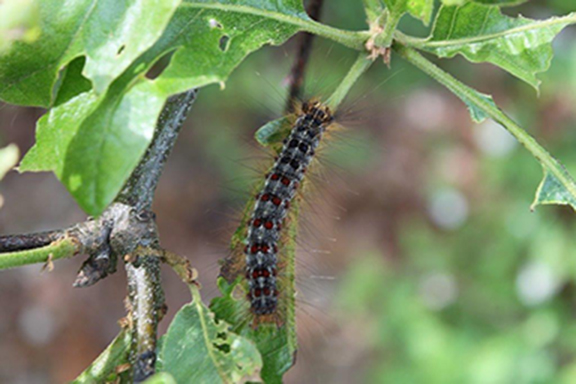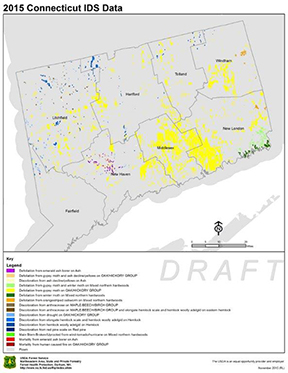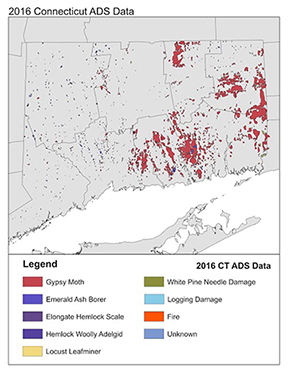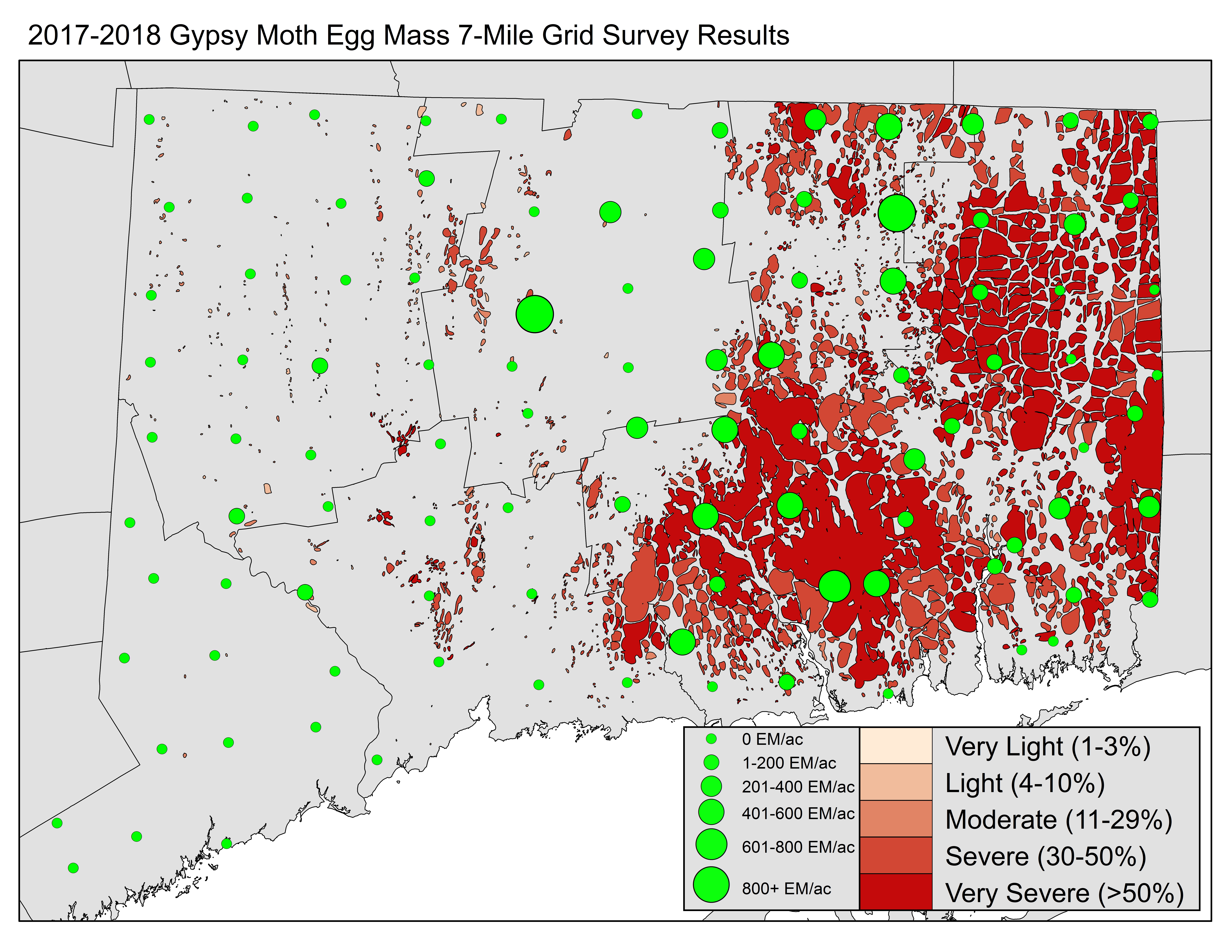Spongy Moth (Lymantria dispar)

Follow this link for a larger printable image.

Follow this link for a larger 2015 printable map.

Follow this link for a larger 2016 printable map.

Note: as of March 2022, the Entomological Society of America adopted the name spongy moths to refer to gypsy moths out of respect for the Romani people.
Follow this link for a larger 2018-2019 Gypsy Moth Egg Mass 7-Mile Grid Survey Results
Aerial survey map of Connecticut showing areas defoliated by the gypsy moth in 2018 (287,013 acres) overlaid with the results of the 2018-2019 CAES egg mass 7-mile grid ground survey, which provides an indication of activity for 2019. Survey and map produced by the Office of the State Entomologist, CAES. Aerial survey conducted by Deputy State Entomologist Dr. Victoria Smith and Plant Inspector Tia Blevins. Egg mass survey by State Survey Coordinator Katherine Dugas, Plant Inspectors Tia Blevins and Jeffrey Fengler, and Zachary Brown; map prepared by Zachary Brown. Aerial survey is funded by the U.S. Forest Service.

Follow this link for a larger 2017-2018 Gypsy Moth Egg Mass 7-Mile Grid Survey Results
Aerial survey map of Connecticut showing areas defoliated by the gypsy moth in 2017 overlaid with the results of the 2017-2018 CAES egg mass 7-mile grid ground survey. Survey and map produced by the Office of the State Entomologist, CAES. The aerial survey is funded by the U.S. Forest Service.
Further Information
The Gypsy Moth Presentation (PDF Format)
Factsheets
NEW--May 2019--The Gypsy Moth (PDF Format)
Bulletins
B153 (1906) The Gypsy Moth and the Brown-Tail Moth. Britton, W.E. (PDF Format)
B186 (1915) The Gypsy Moth. Britton, W.E. (PDF Format)
B375 (1935) The Gypsy Moth. Britton, W.E. (PDF Format)
B646 (1961) Population Ecology of the Gypsy Moth, Porthetria dispar L. (Lepidoptera: Lymantridae). Bess, H.A.
B655 (1963) The Gypsy Moth Problem. Fisher, H.J.
B658 (1963) Effect of Defoliation by the Gypsy Moth. Turner, N. (PDF Format)
B680 (1966) Differences in Development of Strains of the Gypsy Moth, Porthetria dispar (L.). Leonard, D.E.
B723 (1971) Relation of Insect Defoliation to Mortality in Connecticut Forests. Stephens, G.R. (PDF Format)
B724 (1971) Aerial Application of Insecticides for Control of the Gypsy Moth, With Studies on Effects on Non Target Insects and Birds. Doane, C.C.; Schaefer, P.W.
B735 (1973) Aerial Applications of Bacillus thuringiensis Against Larvae of the Elm Spanworm and gypsy Moth and Effects on Parasitoids of the Gypsy Moth. Dunbar, D.M.; Kaya, H.K.; Doane, C.C.; Anderson, J.F.; Weseloh, R.M.
B749 (1974) Defoliation in Connecticut 1969-1974. Anderson, J.F.; Gould, S.W.
B797 (1981) The Gypsy Moth in Connecticut: 1. Defoliation 1975-1980. 2. Review of Biological Control Studies. Anderson and Weseloh.
B807 (1982) Aerial Spray Test with Bacillus thuringiensis for Control of the Gypsy Moth in Connecticut. Andreadis,T.G.; Dubois,N.R.; Weseloh, R.M.; Moore, R.E.B.; Anderson, J.F.; Lewis, F.B.
B938 (1996) Predicting Defoliation by the Gypsy Moth in Connecticut. Weseloh, R.
B987 (2003) A Computer Model of the Gypsy Moth and its Fungal Pathogen. Ronald M. Weseloh (PDF Format)
Frontiers of Plant Science
Volume 6, number 1, Fall 1953
The Gypsy Moth Outbreak by Neely Turner
Volume 7, number 1, Fall 1954
Report on the Gypsy Moth by Neely Turner
Volume 10, number 2, Spring 1958
Where Do We Stand On Gypsy Moth Control? By Neely Turner
Volume 15, number 1, Fall 1962
How Better Forest Management Can Help Control Gypsy Moths by Neely Turner
Volume 18, number 1, Fall 1965
Rearing Gypsy Moths in the Laboratory by David E. Leonard and Charles C. Doane
Volume 20, number 2, Spring 1968
Gypsy Moths Respond to Crowding by David E. Leonard
Volume 28, number 2, Spring 1976
Improving a Wasp Parasite to Control the Gypsy Moth by Ronald M. Weseloh
Volume 32, number 2, Spring 1980
Studying parasites of the gypsy moth to increase their effectiveness by Ronald
M. Weseloh
Volume 32, number 3, Fall 1980
The Gypsy Moth – A Special Issue: Frontiers of Plant Science
Volume 34, number 1, Fall 1981
The gypsy moth in Connecticut during 1981
Volume 34, number 2, Spring 1982
Four registered pesticides effective against gypsy moth by Robert E.B. Moore
Volume 35, number 1, Fall 1982
Bacillus thuringiensis applied by air works against the gypsy moth by Paul
Gough
Volume 35, number 2, Spring 1983
Gypsy moth has many natural enemies by Ronald M. Weseloh
Volume 39, number 1, Fall 1986
Gypsy moth outbreaks in Connecticut in the 1980's by John F. Anderson
Biological control of gypsy moths: help from a beetle by Ronald M. Weseloh
Volume 39, number 2, Spring 1987
Bacterial
pesticide sprayed by helicopter controls gypsy moth in Ledyard by John F.
Anderson
Volume 42, number 2, Spring 1990
Fungus from Japan causes heavy mortality of gypsy moth by Theodore G. Andreadis
and Ronald M. Weseloh
Volume 43, number 2, Spring 1991
Many gypsy moth caterpillars destroyed by fungus for second year by Ronald M.
Weseloh and Theodore G. Andreadis
Volume 54, number 2, Spring 2002 (PDF Format)
The Fungus and the Gypsy Moth: A Tale of Two Foes and the Happy Outcome
from Their Deadly Battles by Ronald M. Weseloh
Press Releases
June 13, 2016--Gypsy Moth 2016 Outbreak May be Over Natural Fungus Causing Widespread Mortality (PDF Format)

